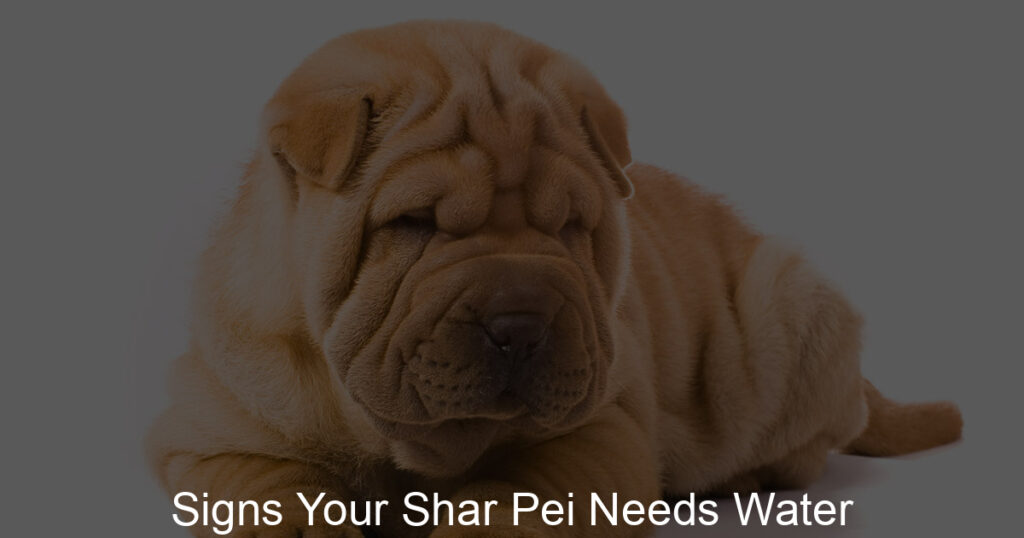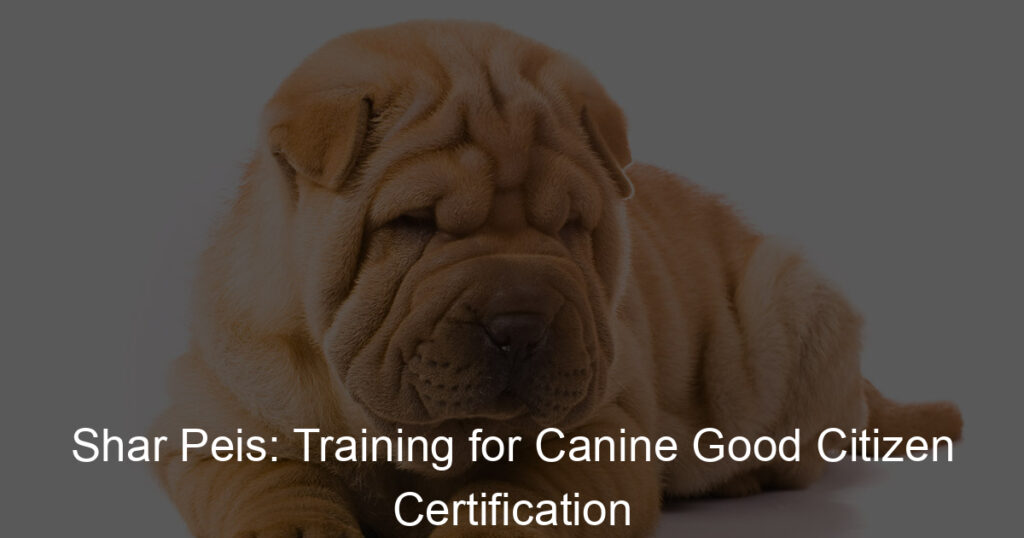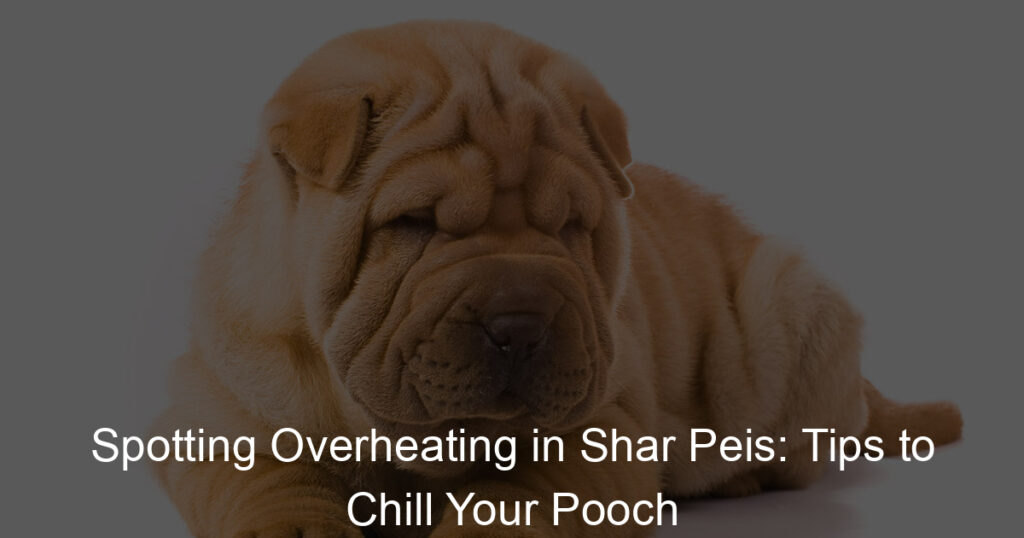Introduction: Understanding Your Shar Pei’s Hydration Needs
Hydration is a crucial aspect of your Shar Pei’s health and wellbeing. Just like humans, dogs need to stay hydrated to maintain their overall health and vitality. This is especially true for Shar Peis, a breed known for its unique physical characteristics and health needs. In this section, we will delve into the importance of hydration for your Shar Pei and provide an overview of their water needs.
- Importance of hydration for Shar Pei
- Overview of Shar Pei water needs
Understanding your Shar Pei’s hydration needs is the first step towards ensuring their health and happiness. In the following sections, we will discuss how to recognize signs of dehydration, understand their drinking habits, and care for a dehydrated Shar Pei.
Recognizing Signs of Dehydration in Your Shar Pei
Keeping your Shar Pei hydrated is essential for their health. But how do you know if your furry friend is dehydrated? Here are some physical signs to watch out for:
Physical Signs
- Changes in skin elasticity: One of the first signs of dehydration in dogs is a loss of skin elasticity. This means that when you gently pull up your Shar Pei’s skin, it doesn’t spring back as quickly as it should. Instead, it may stay tented or go back slowly. This is due to the lack of moisture in their body. Wikipedia provides more information on this.
- Changes in gum color: Another sign to look out for is changes in your Shar Pei’s gum color. Healthy gums should be a nice bubble gum pink. If they’re dehydrated, their gums may look pale or white. This is because dehydration affects blood circulation.
- Changes in eye appearance: Dehydration can also affect your Shar Pei’s eyes. They may appear sunken or dull, and the area around the eyes may seem dry or wrinkled. This is a serious sign of dehydration and requires immediate attention.
Remember, these are just physical signs. If you notice any changes in your Shar Pei’s behavior, such as increased thirst or lethargy, it’s important to consult with a vet immediately. Dehydration can lead to serious health issues if not addressed promptly.
Behavioral Signs
Just like us humans, dogs can also show changes in their behavior when they’re not feeling well. If your Shar Pei is dehydrated, you might notice some of these behavioral changes:
- Increased thirst and water consumption: One of the first signs of dehydration in dogs is an increase in thirst and water consumption. If your Shar Pei is drinking more water than usual, it could be a sign that they’re trying to compensate for the loss of fluids. This could be due to a number of reasons, including hot weather, physical activity, or certain health issues. Wikipedia has more information on why dogs might drink more water than usual.
- Lethargy or decreased activity: Another sign of dehydration in dogs is lethargy or decreased activity. If your Shar Pei is less active than usual or seems tired all the time, it could be a sign that they’re not getting enough fluids. This can make them feel weak and sluggish. Remember, dogs can’t tell us when they’re feeling unwell, so it’s up to us to notice these changes in their behavior.
- Changes in eating habits: Changes in eating habits can also be a sign of dehydration in dogs. If your Shar Pei is eating less than usual or has lost interest in food, it could be because they’re feeling unwell. Dehydration can make dogs feel nauseous and reduce their appetite. It’s always a good idea to keep an eye on your dog’s eating habits and consult a vet if you notice any sudden changes.
Remember, these are just signs and not definitive proof of dehydration. If you notice any of these changes in your Shar Pei’s behavior, it’s always a good idea to consult a vet to rule out any serious health issues.
Understanding Shar Pei Drinking Habits
Just like us humans, our furry friends, the Shar Peis, also need to stay hydrated for their overall health. But how much water do they really need? And what factors can affect their water consumption? Let’s dive in and find out!
- Typical water intake for Shar Pei
- Factors affecting Shar Pei water consumption
- How to monitor your Shar Pei’s drinking habits
Remember, staying hydrated is key to your Shar Pei’s health. So, make sure they always have access to fresh, clean water. And if you have any concerns about their drinking habits, don’t hesitate to seek professional advice.
Health Issues Related to Dehydration in Shar Pei
Dehydration is not just about feeling thirsty. It can lead to serious health issues in your Shar Pei. Let’s take a look at some of the most common problems that can arise.
Common Health Problems
- Kidney Disease
- Urinary Tract Infections
- Heat Stroke
Remember, prevention is the best cure. Always make sure your Shar Pei has access to fresh, clean water, especially in hot weather. And if you notice any signs of these health problems, don’t hesitate to seek veterinary care.
Long-Term Effects of Chronic Dehydration
Chronic dehydration is a serious condition that can have long-lasting effects on your Shar Pei’s health. It’s not just about feeling thirsty; it’s about the overall impact on your dog’s body and quality of life. Let’s delve into the long-term effects of chronic dehydration:
- Impact on Overall Health and Lifespan
- Impact on Quality of Life
In conclusion, it’s crucial to keep an eye on your Shar Pei’s hydration status. Chronic dehydration is a serious condition that can negatively impact your dog’s health and lifespan, as well as its quality of life. By understanding the signs and ensuring your dog has access to fresh water, you can help prevent this condition and keep your Shar Pei healthy and happy.
Caring for a Dehydrated Shar Pei
Dehydration in Shar Peis can be a serious issue. It’s essential to know when to seek veterinary care, how to provide home care, and how to prevent future dehydration. Let’s dive in and learn more about each of these aspects.
- When to seek veterinary care
- Home care tips for a dehydrated Shar Pei
- Preventing future dehydration
Remember, your Shar Pei’s health is in your hands. Stay vigilant for signs of dehydration and take action when necessary. With the right care and attention, you can keep your furry friend happy, healthy, and hydrated.
Conclusion: Key Takeaways for Shar Pei Care
As we wrap up our discussion on Shar Pei care, it’s important to remember that your furry friend’s health and happiness largely depend on you. There are several key points to keep in mind to ensure your Shar Pei stays hydrated and healthy.
- Importance of monitoring water intake: Your Shar Pei’s water intake is crucial to their overall health. Water helps regulate body temperature, aids digestion, and keeps their skin and coat healthy. Make sure your Shar Pei has access to fresh, clean water at all times. A general rule of thumb is that your dog should drink an ounce of water per pound of body weight each day. But remember, this can vary depending on their age, diet, and activity level.
- Signs of dehydration to watch for: Dehydration in Shar Peis can be serious if not addressed promptly. Signs to watch for include lethargy, dry nose and gums, excessive panting, and loss of appetite. If you notice any of these signs, it’s important to seek veterinary attention immediately. Learn more about dehydration in dogs here.
- How to provide the best care for your Shar Pei: Apart from ensuring they stay hydrated, regular vet check-ups, a balanced diet, and plenty of exercise are key to your Shar Pei’s well-being. Also, remember that Shar Peis are prone to certain health issues like skin problems and eye disorders. Regular grooming and keeping an eye out for any changes in their behavior or appearance can help catch any potential issues early.
In conclusion, caring for a Shar Pei requires diligence and a keen eye for their needs. Remember, a hydrated and well-cared-for Shar Pei is a happy and healthy Shar Pei. Here’s to many wonderful years with your furry friend!














